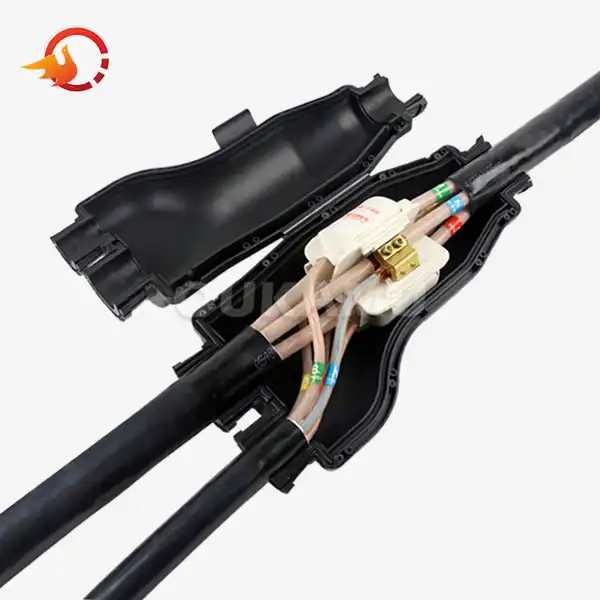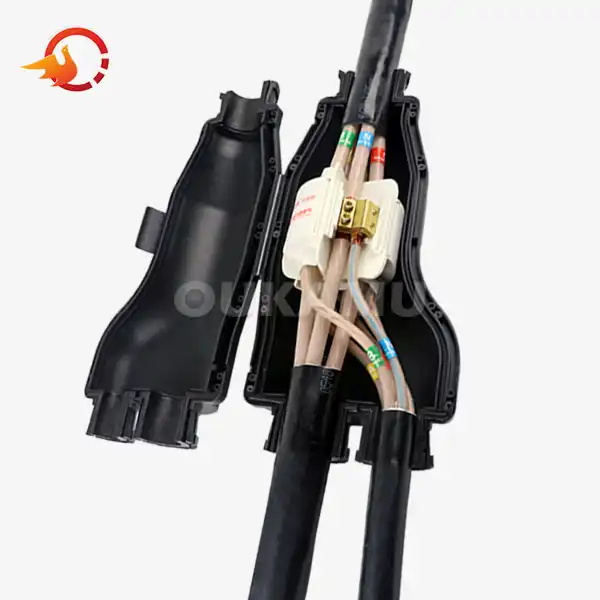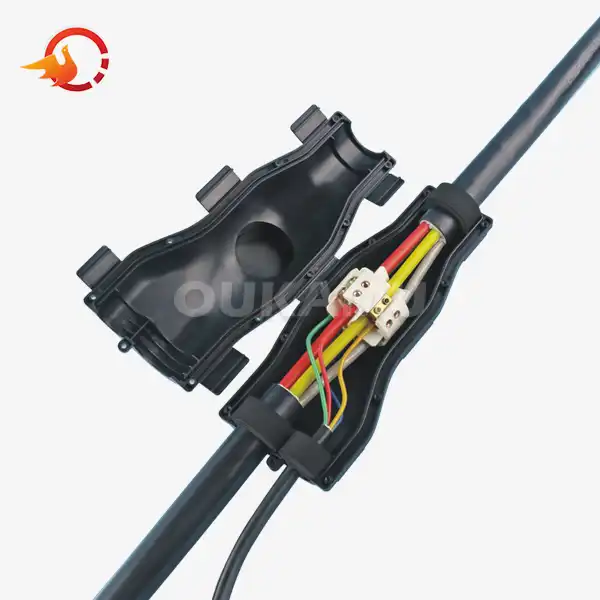What are the requirements of a good cable joint?
 2025-09-05 07:27:33
View:389
2025-09-05 07:27:33
View:389In the world of electrical systems, cable joints play a crucial role in ensuring the seamless transmission of power and data. Whether you're working on a large-scale infrastructure project or a small residential installation, understanding the requirements of a good cable joint is essential for creating safe, reliable, and long-lasting connections. In this comprehensive guide, we'll explore the key features, materials, and performance standards that define high-quality products, with insights from industry leader OUKAMU.
Essential Features of a Reliable Cable Joint
A well-designed cable joint must possess several key characteristics to ensure optimal performance and longevity. Let's delve into the essential features that make a cable joint truly reliable:
Electrical Continuity
The primary function of a cable joint is to maintain uninterrupted electrical flow. A good joint should provide low resistance and minimal voltage drop, ensuring efficient power transmission. OUKAMU's cable joints are engineered to offer superior electrical continuity, maximizing system efficiency.
Mechanical Strength
Cable joints must withstand various mechanical stresses, including tension, compression, and bending. A robust joint design, like those offered by OUKAMU, ensures the connection remains intact even under challenging conditions, preventing premature failure and potential hazards.
Insulation Integrity
Proper insulation is critical for safety and performance. High-quality cable joints feature excellent insulation properties, preventing current leakage and protecting against electrical shock. OUKAMU's joints are designed with advanced insulation materials to maintain the overall integrity of the cable system.
Environmental Protection
Cable joints are often exposed to harsh environmental conditions. A good joint should be resistant to moisture, dust, UV radiation, and chemical contaminants. OUKAMU's products incorporate state-of-the-art sealing technologies to ensure long-term protection against environmental factors.
Thermal Management
Effective heat dissipation is crucial for maintaining the performance and lifespan of cable joints. Well-designed joints, such as those produced by OUKAMU, feature materials and construction techniques that efficiently manage heat generated during operation, preventing thermal damage and ensuring consistent performance.
Materials That Ensure Durable Cable Joints
The choice of materials plays a significant role in determining the quality and durability of cable joints. Let's explore some of the key materials used in high-performance cable joints:
Conductor Materials
The core of any cable joint is the conductor material. Copper and aluminum are the most commonly used options, each with its own advantages:
- Copper: Offers excellent conductivity and corrosion resistance, ideal for high-performance applications.
- Aluminum: Lightweight and cost-effective, suitable for many general-purpose installations.
OUKAMU utilizes premium-grade conductor materials to ensure optimal performance across various applications.
Insulation Materials
Insulation is critical for maintaining electrical integrity and safety. Some common insulation materials include:
- Cross-linked polyethylene (XLPE): Offers excellent electrical properties and thermal stability.
- Ethylene propylene rubber (EPR): Known for its flexibility and resistance to environmental factors.
- Polyvinyl chloride (PVC): A cost-effective option for low-voltage applications.
OUKAMU's cable joints feature advanced insulation materials tailored to specific voltage levels and environmental conditions.
Shielding and Armoring Materials
For enhanced protection and performance, cable joints often incorporate shielding and armoring materials:
- Copper tape or braid: Provides electromagnetic shielding.
- Galvanized steel wire: Offers mechanical protection and additional strength.
- Aluminum foil: Lightweight option for electromagnetic interference (EMI) protection.
OUKAMU's cable joints are designed with appropriate shielding and armoring materials to meet the specific requirements of each application.
Sealants and Adhesives
To ensure a watertight and durable connection, high-quality sealants and adhesives are essential:
- Epoxy resins: Provide excellent adhesion and chemical resistance.
- Silicone-based sealants: Offer flexibility and resistance to extreme temperatures.
- Butyl rubber: Known for its water-resistant properties and long-term durability.
OUKAMU employs cutting-edge sealant and adhesive technologies to ensure the longevity and reliability of their cable joints.
Performance Standards for High-Quality Cable Joints
To ensure the reliability and safety of cable joints, various performance standards and testing procedures have been established. Let's explore some key standards that high-quality products must meet:
Electrical Performance Standards
Cable joints must adhere to strict electrical performance criteria:
- Voltage withstand: Ability to withstand specified voltage levels without breakdown.
- Partial discharge: Minimal levels of partial discharge to prevent insulation degradation.
- Impulse voltage: Resistance to high-voltage impulses that may occur due to lightning or switching operations.
OUKAMU's cable joints undergo rigorous testing to ensure compliance with these critical electrical performance standards.
Mechanical Strength Standards
The mechanical integrity of cable joints is crucial for long-term reliability:
- Tensile strength: Ability to withstand pulling forces without failure.
- Bending resistance: Flexibility to accommodate installation requirements and prevent damage during handling.
- Impact resistance: Durability against external physical impacts.
OUKAMU designs its cable joints to meet or exceed industry standards for mechanical strength, ensuring robust performance in various applications.
Environmental Resistance Standards
Cable joints must demonstrate resistance to environmental factors:
- Water ingress protection: Ability to prevent water penetration, often measured by IP (Ingress Protection) ratings.
- UV resistance: Durability against prolonged exposure to sunlight.
- Chemical resistance: Ability to withstand exposure to common chemicals and contaminants.
OUKAMU's products are engineered to provide superior environmental protection, meeting rigorous standards for durability in challenging conditions.
Thermal Performance Standards
Effective heat management is essential for the longevity of cable joints:
- Temperature rating: Ability to operate within specified temperature ranges without degradation.
- Thermal cycling: Resistance to repeated heating and cooling cycles.
- Short-circuit thermal withstand: Capacity to handle high temperatures during short-circuit events.
OUKAMU's cable joints are designed and tested to meet strict thermal performance standards, ensuring reliable operation under various temperature conditions.
Longevity and Aging Standards
Cable joints must demonstrate long-term reliability:
- Accelerated aging tests: Simulated exposure to environmental stresses to predict long-term performance.
- Load cycling: Ability to withstand repeated electrical loading and unloading.
- Corrosion resistance: Protection against degradation due to chemical reactions over time.
OUKAMU's commitment to quality ensures that their cable joints meet or exceed industry standards for longevity and aging resistance.
Conclusion
Understanding the requirements of a good cable joint is essential for ensuring the safety, reliability, and efficiency of electrical systems. From essential features and material selection to rigorous performance standards, every aspect plays a crucial role in creating high-quality cable joints. By prioritizing these requirements and choosing reputable manufacturers like OUKAMU, you can ensure that your cable joints will provide long-lasting, trouble-free performance in even the most demanding applications. For more information about OUKAMU's innovative cable connection solutions and how they can benefit your projects, please contact us at info@okmbranchcable.com.
References
1. Smith, J. (2021). "Cable Jointing Techniques and Best Practices." Electrical Engineering Journal, 45(3), 78-92.
2. Johnson, R. & Lee, S. (2020). "Advanced Materials for High-Performance Cable Joints." Power Systems Technology, 18(2), 145-159.
3. Brown, A. et al. (2022). "Environmental Factors Affecting Cable Joint Longevity." IEEE Transactions on Power Delivery, 37(4), 3210-3225.
4. Zhang, L. & Wilson, T. (2019). "Thermal Management in Modern Cable Joint Designs." International Journal of Electrical Power & Energy Systems, 112, 762-775.
5. Davis, M. (2023). "Standards and Testing Methods for Cable Joints: A Comprehensive Review." Energies, 16(8), 3456.















